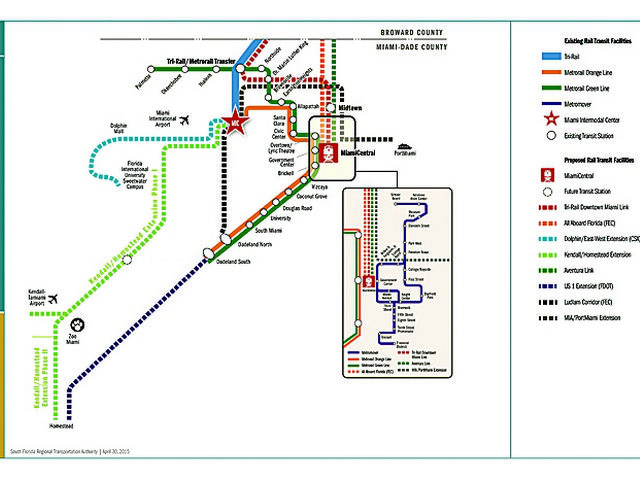
In a new effort to relieve county traffic gridlock, Miami-Dade Commission vice chair Esteban “Steve” Bovo has proposed $102 million outright purchase of an 11-mile section of CSX railroad track in central Miami- Dade for commuter rail use.
Instead, CSX which maintains cargo routes through Kendall to Homestead has asked that Florida Department of Transportation purchase that right-or-way and 24 additional miles of track the freight line owns in the southwestern area of the county.
Initially, a CSX East-West Rail Feasibility Study by Miami-Dade Metropolitan Planning Organization (MPO) proposed service between a station hub at SW 137th Avenue and the Intermodal Center at Miami International Airport, an 11-mile distance paralleling the Dolphin (SR836) Expressway.
That project would schedule 46 weekday train trips with intervening stops at North Tamiami (132nd Avenue); Florida’s Turnpike (122nd Avenue); Malls-FIU-SW Doral (107th Avenue); Fontainebleau (97th Avenue) and Southeast Doral (82nd Avenue).
A second program phase not yet analyzed by MPO would extend passenger service on CSX tracks from NW 137th Avenue southwest through the heart of West Kendall to a second terminus off Krome Avenue south of Kendall Drive.
Following submission of the first study phase, CSX executive Marco Turra responded on July 23 with a list of nine conditions, including a requirement that FDOT purchase all 35 miles of rail service.
Most significantly, CSX wants FDOT to acquire “the entire Homestead Subdivision at a fair market value” to become the lead agency, owner and dispatcher with CSX retaining “exclusive and perpetual freight rights on the line segments.”
For cost comparison, Orlando began a SunRail service in 2014 similar to Florida TriRail after purchase of 61 miles of CSX tracks for about $430 million. Based on that transaction, acquisition of 35 miles of Miami-Dade track (11 miles along SR 836 and an additional 24 in south Miami- Dade) would run the cost to about $245 million.
Bovo, who chairs the commission’s Transportation Committee, believes purchase of the 11-mile segment would deliver the promised east-to-west commuter line voters anticipated when they approved a half-percent sales tax for transit in 2002.
Meeting privately with CSX executives to consider sale of the 11-mile section, he was off to Denver on Aug. 6 to attend a special meeting dealing with that city’s solutions to commuter traffic jams.
Before leaving, Bovo said he plans to meet with FDOT Secretary Jim Buxold to determine the state’s interest in pursuing any CSX purchase, commenting, “I need to let them know how helpful that could be for Miami-Dade County.
“When I assumed the duties of chairman, I made it known publicly that I was determined to identify and implement a major transportation infrastructure project in Miami-Dade County,” Bova said in a statement to the Gazette.
“To be successful this project must serve as an integral building block upon which an integrated system of mass transit can be delivered to our residents,” Bovo said. “Miami-Dade County is home to a substantial number of underutilized freight rail corridors that weave their way through vast portions of the county’s most densely populated communities.
“In addition to studying the viability of commuter rail service to West Miami- Dade County, our research has uncovered additional freight rail corridors throughout the county which can be integrated with our existing heavy rail service to link our suburbs to the urban core.
“One of these rail lines, also owned by CSX Transportation, runs south along Milam Dairy Road from SR 836, runs parallel to SR 874, and winds its way south to Florida City. It is my intention to ask (MPO) to commission a similar study for the Homestead corridor, with an eye towards establishing reliable commuter rail service into downtown. “…
If everything falls into place, a commuter in South Dade would be able to seamlessly move about the county while leaving their car at home. I am not naïve, and do not believe that these projects will supplant private automobiles as the primary means of transportation, but I do believe that these systems will offer residents the option to do so if they desire,” Bovo added.
“I do, however, believe that if we invest the time and resources to get these projects done, future generations will reap the long-term benefits of our labor,” he concluded.







Comments are closed.